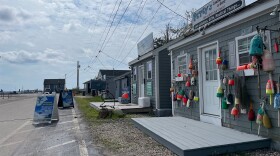As primary elections approach, some Democratic candidates for governor are making an effort to engage New Hampshire’s growing Latino population through canvassing, meet-and-greets and more.
The U.S. Census Bureau estimates Latinos made up 3% of eligible voters in New Hampshire in 2022, about 35,000 voters. However, Latino voters have become a bigger proportion of the electorate in the past decade.
Overall, New Hampshire’s voting population has increased by 10% from 2012 to 2022. In comparison, the state’s Latino voting population grew by 73% during the same time period. This number is projected to double in the next two decades as more young people in the state’s Latino communities become eligible to vote.
Ward 5 in Manchester is one of the most diverse districts in the state but also has one of the lowest rates of voter turnout. Rep. Amanda Bouldin, a Democrat who represents the area at the State House, said there’s a reason people there might feel less inclined to participate in politics.
“Maybe from the outside it could be taken as they're disinterested, but in reality, they're not being catered to in any way,” she said.
Bouldin spent one recent afternoon canvassing Ward 5 on behalf of Democratic gubernatorial candidate Jon Kiper. She has worked for a lot of different political organizations over the years and said voter outreach tends to target voters who have already voted — which means that politicians don’t usually reach out to voters who just turned 18 or got their citizenship recently. In turn, she said that influences the demographics of who shows up to vote and gives preference to older, white voters.
Nationally, 55% of Latinos said that they were not contacted by any campaign in 2024, according to research published by nonprofit advocacy group UnidosUS.
Like many first-generation Latinos, Bouldin learned some Spanish from her Mexican mom. However, she said she doesn’t get the chance to speak it very much and likes to practice when she reaches out to voters. She said door-knocking is hard, but she enjoys reaching out to a population that is undervalued by a lot of political campaigns.
“I enjoy the opportunity to talk to people in Spanish, because I at least hope that I'm acknowledging them, their autonomy and their right to vote,” Bouldin said. “And that can inspire them to get involved, even if English isn't their primary language.”
One of the people Bouldin spoke to during her recent canvassing trip was Ana Román, the owner of Ana Food Market. Román has owned the store for six years and sells Latin food, including empanadas made fresh in-store . She said business has been tough since the pandemic, and she hasn’t gotten any help from the government. She plans on voting this election season, but doesn’t know who she’ll vote for.
Even though Román received a flier from Bouldin about the Kiper campaign, she said that she’s still waiting for a candidate to visit her business and ask her about what she needs. She said this kind of distrust is common in her community, as very few politicians take time to speak directly with them about their concerns.
“We’re scared to vote because there aren’t any politicians showing up saying, ‘Look, I can do this for the community, I can do that for you. I can help with this,’” Román said, in Spanish. “So, what kind of assurances do we have to go vote? None.”
For other voters, the chance to meet a candidate is an important part of deciding who to vote for. Colleen Island Mateo had the chance to do that recently when she hosted a meet-and-greet with Democratic gubernatorial candidate Joyce Craig at her restaurant in Nashua. Tropical Point serves Dominican food, which was served at an informal gathering where Craig spoke to a group of about 25 people through an interpreter, answered questions and snapped photos.
As a mother of two and restaurant owner, Mateo said she was voting on childcare and business issues. She is passionate about connecting her community with resources and educating them on their political power. She said it meant a lot to her to host this event at her restaurant.
“So the fact that this candidate, Joyce [Craig], came out her way to come to my small business restaurant is huge,” Mateo said. “Not only because she came and who she is, but she took the time out to come to this small, you know, Dominican-owned, minority-owned, women-owned business.”
The other major Democratic gubernatorial candidate, Cinde Warmington, said she was proud to work with Latino leaders all across the state to ensure her campaign is reaching voters in the Latino community.
“New Hampshire’s diversity is one of its greatest strengths and we must do more to ensure that diversity is reflected in our public institutions,” Warmington said in an email comment. “As governor, I will make sure every Granite Stater has the freedom to thrive.”
At time of publication, the campaigns for Republican candidates Kelly Ayotte and Chuck Morse did not respond to a request for comment about how they are trying to connect with Latino voters in New Hampshire.





